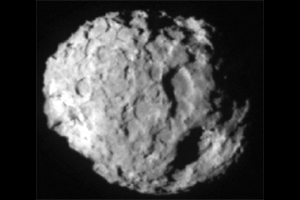"What's in a comet?" I quizzed. Hands went up, and answers were plucked out. "Water." "Ice." "Very small pebbles."
"Good answers. Let's start cookin'…."
One by one, and two at a time, I called up volunteers (no lack of these at all) to add ingredients into the mixing bowl.
Water first—two cupfuls. What else? The Chef helped out his students a bit: pebbles are fine, but what are they?
Silicon, calcium, to name a couple—so we add a source of these: sand. Then, iron, and magnesium—two more known comet constituents. Source? Dirt! Dirt can contain these, among other things.
For the carbon in our comet, we added—carbon: black charcoal dust; just a dusting.
There is nitrogen mixed up in comets too, so we had to add some to our concoction. Our nitrogen source (other than all the gaseous nitrogen floating about us in the air) is ammonia—NH3 (what's a little hydrogen in the compound, more or less? In fact, ammonia itself has been detected in comets, so our recipe is true).
Organic compounds—carbon based organic molecules—have also been detected in comets…so we add a couple glugs of corn syrup. Okay, that's cheating a bit, because comet organics aren't known to come from agricultural products….
And lastly, but not leastly, is the two-in-one ingredient: contained in a plastic bag, I had the class use mallets to pulverize a few cupfuls of dry ice pellets into a fine powder. This adds not only the carbon dioxide to the material makeup of the Personal Comet, but that which really makes the difference between a bowlful of slightly sweet mud and the astral nugget of a comet: COLD! Space is cold, and so is dry ice.
In goes the frigid, dry frost, and out erupts clouds of billowing vapor—very exciting stuff. Now the Chef had to work fast, stirring and mixing and shaking the brew, and then squeezing the convulsive mixture in its plastic bag, with gloved hands, into a hard, solid lump. It takes a lot of squeezing, as it turns out….
Is it done yet?
I pulled out of the bag our Personal Comet, holding it out for the kids to marvel at—and they did. The double-fist-sized, dirty whitish, somewhat gritty hard blob is covered with pits and knobs and spouting plumes vapor. And, magically, it looks almost identical to a photograph of the nucleus of comet Wild 2, taken by NASA's Stardust spacecraft some years ago.
Everyone got to touch the comet—quickly, because it was quite cold—and make a personal connection with a tiny piece of the heavens. Now, I think, these kids are armed with an experience that will make their first comet-observing experience (yet to come for many of them!) a bit deeper, as I hope when they do see the vastly awesome sight in the sky, or through the eyepiece of a telescope, they'll also remember what it's like to touch a comet, or smell a comet, or see one spouting vapor right before them, in the palm of their hand….
37.8148 -122.178
 Comet Wild 2, as imaged by NASA's Stardust spacecraft.Nothing seems to capture the pure grandeur and extra-Earthly splendor of outer space like a comet: pure white cosmic snow, shining brilliant in the Sun's radiance, a vastly long tail of silky celestial gossamer…unreachable, untouchable, unspoilable….
Comet Wild 2, as imaged by NASA's Stardust spacecraft.Nothing seems to capture the pure grandeur and extra-Earthly splendor of outer space like a comet: pure white cosmic snow, shining brilliant in the Sun's radiance, a vastly long tail of silky celestial gossamer…unreachable, untouchable, unspoilable….